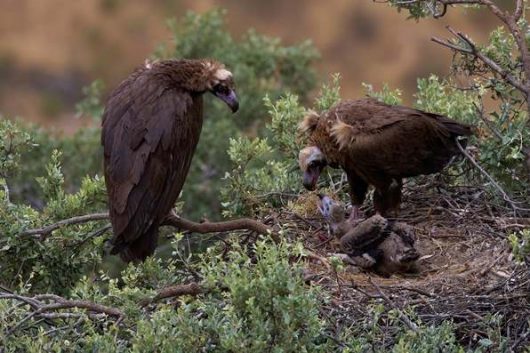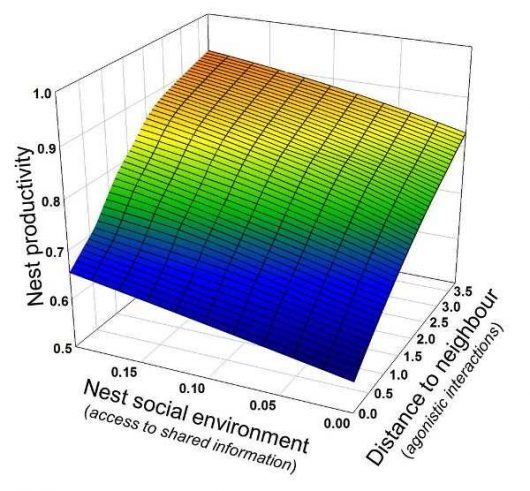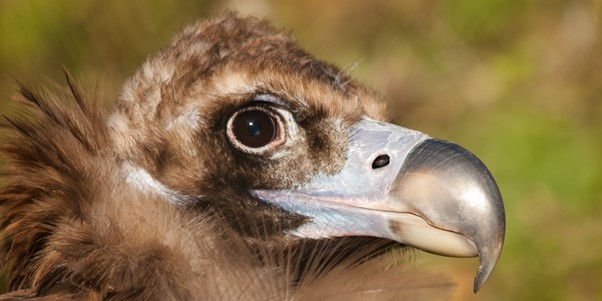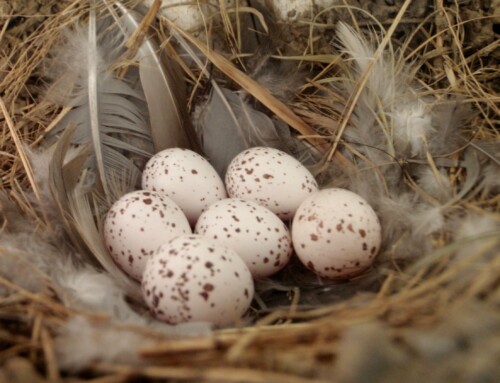Trade-off between the benefits and costs of coloniality in a recovering population of Cinereous Vultures
LINKED PAPER
Density-dependent productivity in a colonial vulture at two spatial scales. Fernández-Bellon, D., Cortés-Avizanda, A., Arenas, R. & Donázar, J.A. 2016. Ecology. DOI: 10.1890/15-0357.1. VIEW
Why do some bird species nest in colonies while others defend territories? Moreover, why do some colonial species breed in tightly packed groups, while others spread their nests over large areas?
We studied a recovering population of an endangered avian scavenger: the Cinereous Vulture, Aegypius monachus. This species, classified as Near Threatened by the IUCN, has one of its strongholds in the Iberian Peninsula where nearly 90% of the European population breeds. Using long term data (2002-2010) from four colonies in southern Spain (overall yearly population size of 200-300 pairs), we set out to assess what factors influenced breeding output, and specifically, whether these colonies were showing signs of saturation after recent decades of population growth.
We evaluated Cinereous Vulture breeding output at two spatial scales (colony and nest site) and assessed if and how these were influenced by environmental and topographical variables and by factors indicative of density dependence. Previous research has described two competing theories to explain density dependence (Grünkorn et al 2014). On the one hand, as population densities increase, competition for the best breeding spots may push recruits to nest in sub-optimal habitats, resulting in reduced breeding output for these individuals (habitat heterogeneity hypothesis). Alternatively, growing densities may result in increased direct competition between individuals for resources, resulting in lower breeding output across the population (individual adjustment or interference competition hypothesis). To tease apart these two hypotheses, we tested whether only new pairs had lower productivity (habitat hypothesis) or whether increased agonistic interactions reduced productivity (interference hypothesis).
Our results indicated the existence of density-dependent processes at both the colony and nest site scale, suggesting that these populations are currently approaching saturation. Furthermore, we found evidence that, in our study, this was mediated by interference competition between breeding pairs. As colonies grew in size, nests packed closer together. This meant that breeding pairs spent more time chasing off neighbours and protecting their nests, and less time tending to their young. In some colonies, this problem may have been accentuated by the aggregation of non-breeding juveniles of the same species, but also of immature birds of Griffon Vultures, Gyps fulvus (Fig. 1).

Interestingly, our results showed that two of the factors which we used to test for interference competition appeared to operate in contradictory ways. Distance to nearest neighbouring nest (a proxy for the frequency of agonistic interactions at each nest) was positively related to productivity, i.e. those nests which were packed close together (and had frequent agonsitic interactions) were more likely to fail. On the other hand, the nest’s social environment (a measure of the relative position of a given nest within the colony; a modified version of Moilanen and Hanski’s index (1998)) was also positively related to productivity, suggesting that nests that were well situated within the colony were more likely to succeed in fledging a chick. While this might seem confusing at first (surely a nest that is ‘well positioned’ within the colony is also close to neighbouring nests!!), it gives insight into a trade-off between the costs and benefits of coloniality in this species.
A good position within the colony would give a nesting pair access to shared information, but if neighbours nested too close by this may result in frequent agonistic interactions. This trade-off is easily explained by means of an example. Imagine a parent bird at a nest overlooking two other nests. At one of these neighbouring nests an adult returns from a southerly direction after a foraging trip, but has an empty crop and its chick goes hungry. At the second nest however, an adult returning from a northerly direction arrives with a full crop and is able to feed its chick (Fig. 2). This sort of information would be more readily available to pairs at nests which were ‘well positioned’ within the colony. Thus, the nest’s social environment is acting as a proxy for access to shared information. If however, a new pair nests very close to our example parent, it will now have to dedicate more of its time to watching the coming and goings of the new pair, which often fly uncomfortably close by. At times, it may even be involved in squabbles if the new pairs flies too close to its nest and chick. This means more energy is spent on these agonistic behaviours and less on looking after the upbringing of the chick, with obvious consequences for productivity.

We can visually inspect this trade-off (Fig. 3) by fixing all other factors in our models and graphing the changes in productivity at different values of distance to neighbour (proxy for agonistic interactions) and the nest’s social environment (proxy for shared information). As a nest’s access to shared information improves, so does productivity. But at the same time, the further a nest is from its nearest neighbour, less effort is dedicated to agonistic interactions and productivity increases. Overall, productivity will be optimised for those nests with a good position within the colony, but where neighbours are not too close.

While we were not able to specifically assess agonistic interactions between pairs, fieldwork records show that these types of behaviours were observed more frequently at those colonies which our models showed to be at highest densities. Recent research has also provided empirical evidence to support our interpretation of the importance of shared information in colonial vultures. By GPS-tracking Griffon Vultures, Harel et al (2017) have shown that when foraging, individuals with no up to date information on food sources will follow birds which have recently visited (or been within detection distance of) carcasses.
As is often the case with science, our research has answered some questions, but also raised new ones. Our research reveals that some of the main colonies of Cinereous Vultures in the Iberian Peninsula are showing clear signs of approaching saturation. New pairs are settling in existing colonies, leading to density-dependent processes which may reduce breeding output and population viability. Thus, long-term survival of the species will require large areas of land meeting certain requirements to host breeding pairs. Our findings also give insight into a trade-off that explains productivity at Cinereous Vulture nests. But could this trade-off also be explaining the spatial structure of these colonies? Furthermore, could this trade-off be present in other colonial species? And if so, does it help explain why some colonial species form tightly packed colonies while others spread their nests over larger areas?
References and further reading
Grünkorn, T., Potiek, A., Looft, V., Jonker, R.M., Chakarov, N. & Krüger, O. 2014. Territory quality affects the relative importance of habitat heterogeneity and interference competition in a long-lived territorial songbird. J. Avian Biol. 45: 15–21. VIEW
Harel, R., Spiegel, O., Getz, W.M. & Nathan, R. 2017. Social foraging and individual consistency in following behaviour: testing the information centre hypothesis in free-ranging vultures. Proc. R. Soc. B 284: 20162654. VIEW
Moilanen, A. & Hanski, I. 1998. Metapopulation dynamics: effects of habitat quality and landscape structure. Ecology 79: 2503. VIEW
Image credit
Featured image: Cinereous Vulture Aegypius monachus © Darío Fernández-Bellon
Blog posts express the views of the individual author(s) and not those of the BOU.
If you want to write about your research in #theBOUblog, then please see here.





